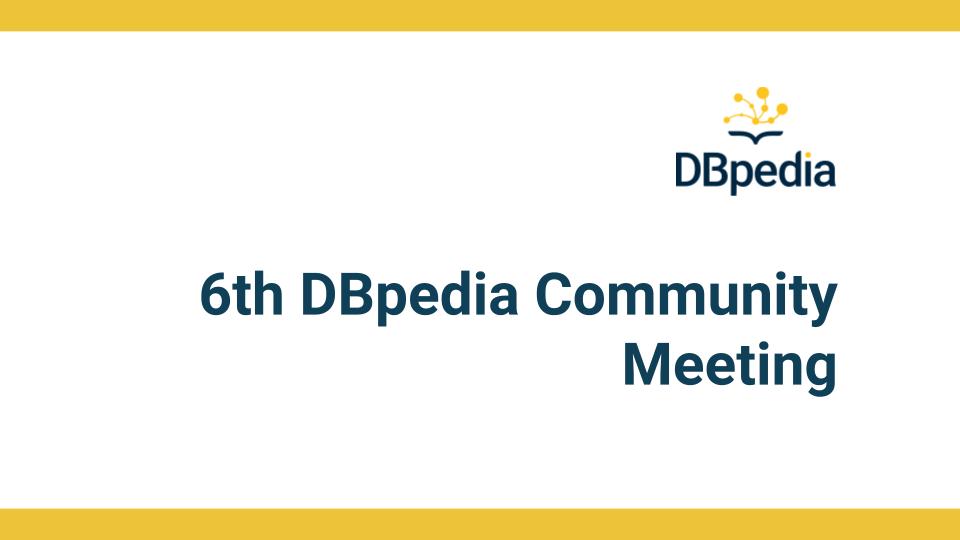Read the final report on our blog: 6th DBpedia Community Meeting in The Hague 2016
Following our successful meetings in Europe & US our next DBpedia meeting will be held at The Hague on February 12th (with welcome reception by TNO on 11th), hosted by the National Library of the Netherlands.
Quick facts
- Web URL: http://wiki.dbpedia.org/meetings/TheHague2016
- Hashtag: #DBpediaDenHaag
- When: February 11th-12th, 2016
- Where:
- February 11th: TNO – New Babylon, Anna van Buerenplein 1, 2595 DA The Hague, Netherlands (directions)
- February 12th: National Library of the Netherlands, Prins Willem-Alexanderhof 5, 2595 BE The Hague, Netherlands (directions)
- Host: National Library of the Netherlands (http://www.kb.nl)
- Call for Contribution: submission form
- Registration: Free to participate but only through registration (Option for DBpedia support tickets)
Acknowledgments
If you would like to become a sponsor for the 6th DBpedia Meeting, please contact the DBpedia Association
 |
National Library of the Netherlands
For hosting the meeting and helping with the organization |
 |
ALIGNED – Software and Data Engineering
For funding the development of DBpedia as a project use-case and covering part of the travel cost |
| Institute for Applied Informatics
For supporting the DBpedia Association |
|
 |
OpenLink Software
For continuous hosting of the main DBpedia Endpoint |
 |
SEMANTiCS 2016: 12-15 Sep in Leipzig
For sponsoring part of the travel costs of DBpedia members |
 |
TNO innovation for life
For hosting the welcome reception on the 11th |
Organisation
- Enno Meijers, National Library of the Netherlands, Dutch DBpedia
- Gerard Kuys, Ordina, Dutch DBpedia
- Gerald Wildenbeest, Saxion, Dutch DBpedia
- Richard Nagelmaeker, Dutch DBpedia
- Monika Solanki, University of Oxford, DBpedia Ontology
- Julia Holze, DBpedia Association
- Sandra Praetor, DBpedia Association
- Dimitris Kontokostas, AKSW/KILT, DBpedia Association
- Sebastian Hellmann, AKSW/KILT, DBpedia ASsociation
Registration
Attending the DBpedia Community meeting is free, but you need to register. You can optionally choose a DBpedia support ticket.
Call for Contribution
Please submit your proposal through our web form.
Contribution proposals include (but not limited to) presentation, posters, demos, lightning talks and session suggestions.
Location / Venue
The meeting will take place at Prins Willem-Alexanderhof 5, 2595 BE The Hague, Netherlands at the National Library of the Netherlands building. See here for detailed directions.
Getting to the meeting by plane, you can use the Schiphol or Rotterdam airpots. Dusseldorf could also be an option but needs a 2.5h train connection.
Speakers
Paul Groth, Disruptive Technology Director @ Elsevier LabsPaul Groth holds a Ph.D. in Computer Science from the University of Southampton (2007) and has done research at the University of Southern California and the VU University Amsterdam. His research focuses on dealing with large amounts of diverse contextualized knowledge with a particular focus on the web and science applications. This includes research in data provenance, data science, data integration and knowledge sharing. Paul was co-chair of the W3C Provenance Working Group that created a standard for provenance interchange. He is co-author of Provenance: an Introduction to PROV; The Semantic Web Primer: 3rd Edition as well as numerous academic articles. Paul’s personal website is pgroth.com and he blogs about his research and technology on ThinkLinks. |
| Marco Brattinga and Arjen Santema, Land Registry and Mapping Agency (Kadaster)
The Dutch Cadastre exploits several national key registers (cadastral registration, topographic map) and information nodes (addresses and buildings, real estate value, cables and pipelines, large scale topographic map). Marco Brattinga is principal consultant at Ordina. Arjen Santema works as consultant tactical information management and innovations at the Cadastre. They share the passion for semantics and practices for publishing data and metadata on the web. Together they developed a framework to describe the data and metadata in a registration in relation to a concept schema that describes what the registration is about and helps to understand this. By separating the concept schema from the data and metadata model they created a taxonomy with domain experts, that contains implementation independent definitions. On the other side they built a data model or an ontology for specific goals. They will present the ideas behind this framework and show some examples from the cadastral registration, the topographic map and the information node addresses and buildings. |
Antoine Isaac and Hugo Manguinhas, EuropeanaAntoine Isaac and Hugo Manguinhas are members of the R&D team at Europeana.eu, the platform for Europe’s digital cultural heritage from libraries, museums and archives. We facilitate, coordinate and promote technological innovation for data aggregation, enhancement and dissemination of digital cultural heritage data and its associated services within the Europeana network. Our activities focus notably on data exchange, data quality, multilingualism and search. |
Marco de Niet, DEN FoundationMarco de Niet is the director of the DEN Foundation, the Dutch knowledge centre for digital heritage. He is actively involved in both national and international networks that focus on innovation with cultural heritage assets, including the Europeana Members Council. He is advisor to the policy officers of the Dutch Ministry of Culture that are responsible for the digital heritage strategies on the national level. He is responsible for the ENUMERATE Framework (currently part of Europeana) used for measuring the progress of digitisation in Europe. He is a member of the Dutch Unesco Memory of the World Committee, a board member of the Dutch Museum Register and a member of the Council for Dutch Language and Literature, which enhances the collaboration between the Netherlands and Flanders. He has a background in cultural information science. |
Schedule
The draft program is in the following table.
Thursday, 11. February: Welcome Reception with snacks and drinks at TNO – New Babylon
| 17:00 | Registration* and gathering on the 10th floor
* For security reasons at the TNO building in The Hague visitors have to register themselves at the reception desk with their ID or passport. Please make sure that you bring yours! |
| 17:30 |
|
| 18:00-19:30 | Social event and poster/demo reception with the following projects:
|
| Friday, 12. February: | DBpedia Community Meeting |
| 10:00 – 10:30 | Meet & Greet |
| 10:30 – 12:00 | Opening Session / chair: Gerard Kuys
room: Auditorium
|
| 12:00 – 12:45 | Lunch Break |
| 12:45 – 14:15 | DBpedia Showcase session
room: Auditorium
|
| 14:15 – 14:30 | Coffee break (15”) |
| 14:30 – 15:45 | PS1: DBpedia ontology / chair: Monika Solanki, University of Oxford
Room: B
3. DBpedia ontology survey results 4. Proposed plan to address action points from the survey results 5. Discussion PS2: DBpedia & Heritage: Challenges and opportunities of reference data for digital heritage / chair: Enno Meijers, Dutch DBpedia (Find the complete presentation here.) Room: Auditorium
|
| 15:45 – 16:00 | Coffee break (15”) |
| 16:00 – 17:15 | BS1: DBpedia Dev session / chair: Dimitris Kontokostas
Room: A Session for developers to talk about technical issues and challenges in DBpedia including:
BS2: DBpedia Tutorial by Markus Freudenberg, AKSW/KILT Room: B a one hour tutorial about Linked Data and DBpedia The tutorial will start with an open talk to assess the level of the audience and then either start with a general introduction to Linked Data or go more into detail and provide an overview and tips and tricks on DBpedia components and what we can do with it. BS3: DBpedia & NLP (partially focused on Cultural Heritage) chair: Sebastian Hellmann, AKSW/KILT Room: Auditorium In this session we will investigate the application of Linked Data on Language Technologies, especially entity linking. The domain is focused partially on Digital Humanities (20) Results of the LIDER project by Christina Unger, CITEC: One of the outcomes of the LIDER support action are guidelines to facilitate the discovery, reuse and exploitation of existing linguistic resources, aiming at the establishment of a new Linked Open Data (LOD) based ecosystem of free, interlinked, and semantically interoperable language and media resources (corpora, dictionaries, lexical and syntactic metadata, images, etc.) for multilingual, cross-media content analytics. In order to show how these guidelines can be realized, I will showcase example services for discovering and querying relevant linguistic resources and for using and linking LOD-aware NLP services. The full presentation is available here. (20) TellMeFirst A Knowledge Domain Discovery Framework by Giuseppe Futia: TellMeFirst (TMF) is an open-source framework that leverages the DBpedia knowledge base and the Wikipedia corpus for classifying documents, achieved by computing a similarity score between the target document and an initial training set. Each DBpedia entity identifies a document of the training set that includes all Wikipedia paragraphs in which the entity appears as wikilink. The training set is composed by entities covered in DBpedia from different knowledge domains (such as Cultural Heritage, Politics, History, Science, Sport). Nevertheless, cultural institutes, companies, and public administrations are much more interested in a classification system that exploits only a subset of these entities, specific for their purposes and needs. During the talk, we will introduce both the transformation pipeline (based on DBpedia Spotlight project) for building a general-purpose training set and a configurable process for building a domain training set. Then, we will report on the differences between classification results obtained by evaluating TMF with the two training sets in an example scenario. The full presentation is available here. (20) Mapping the Bio-economy using DBpedia Spotlight by Chris Davis: |
| 17:15 – 18:00 | Closing session & networking |
| 18:00 + | Continue networking in a near pub over beer |
- Did you consider this information as helpful?
- Yep!Not quite ...

